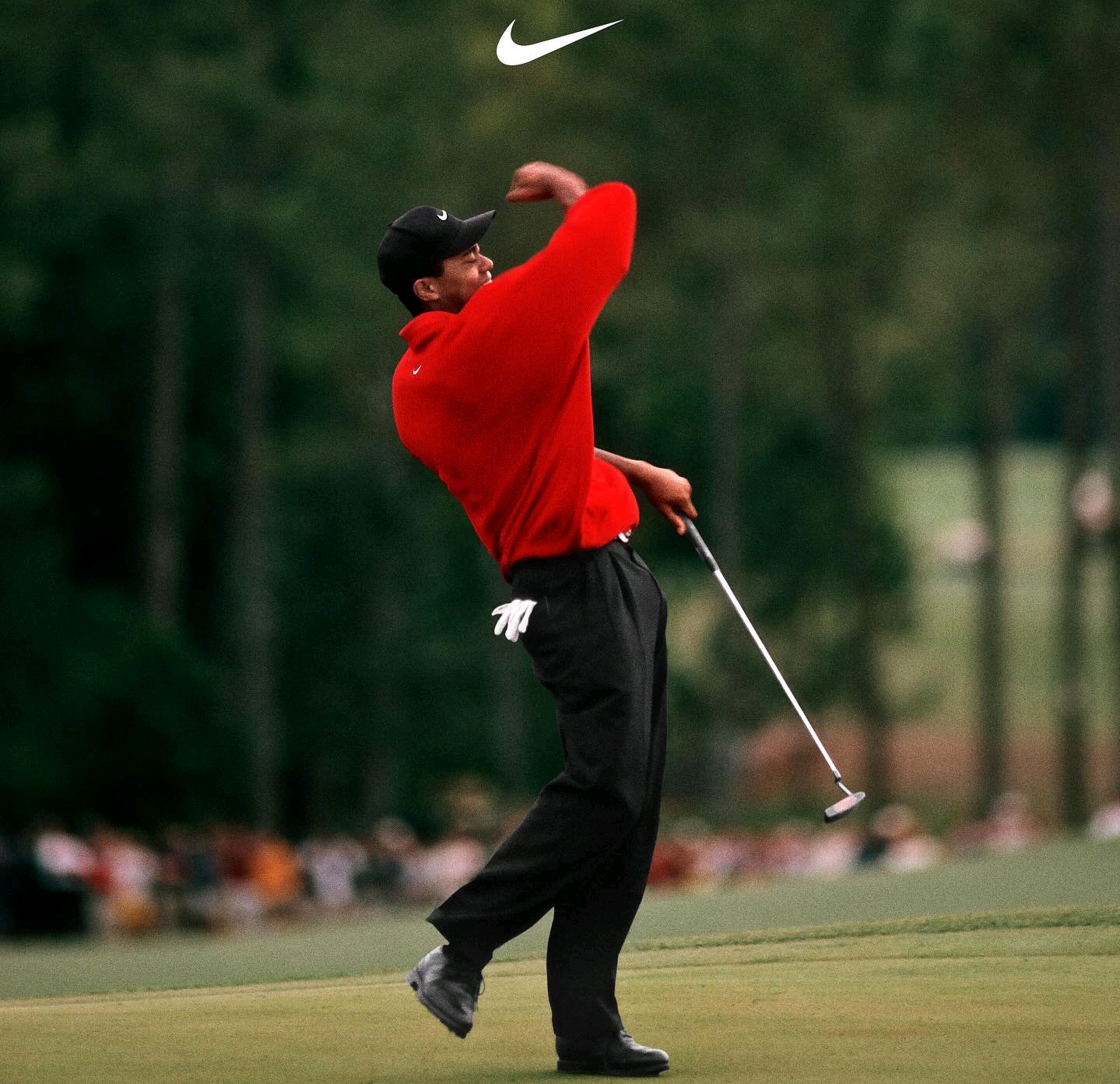
After 27 years, 15 major championships, 82 PGA Tour wins and hundreds of millions of dollars in endorsement contracts, Tiger Woods and Nike announced the end of their collaboration on Monday January 8, 2024.
When Nike and Woods sealed their first deal in 1996, the 20-year-old Tiger Woods – just turned professional – and became beneficiary of a $40 million fortune.
Guaranteed across a five-year deal, the numbers were noteworthy for any athlete, let alone for a freshman like Woods, but he was a surprising professional debutant.
As Nike sought to sign the world’s most talented prodigies in sports, few came more prodigious than the Stanford University starlet, who won the junior world championship six times and became the first person to win the US Amateur three times.
Their decision was right almost right away, and records fell as Woods raced at a breakneck pace toward the top of golf. Woods had won three PGA Tour events within a year of Nike’s iconic “Hello World” advertisement, which was based on his first professional event press conference. He went on to become the fastest player to reach world No. 1 and the youngest winner of The Masters. 1 after becoming a professional.
His status as the dominant force in golf and a global sporting superstar was established when he signed a five-year endorsement contract with Nike in 2000 for an estimated $85 million, an amount that was unprecedented in sporting history at the time.
For Nike, all the more regularly connected with other sports, it was a blessing from heaven. Ben Peppi, a sports commercial expert at JMW Solicitors, claims that the partnership and its impact were “seismic” because Woods signed the sportswear company’s “significant entry” into golf.
For quite a while post-Michael Jordan’s retirement, pre-Cristiano Ronaldo, Tiger Woods was Nike.
As indicated by Peppi, Woods is one of the extraordinary athletes that Nike have had as a brand ambassador however long their partnership would last. He rises above his game – he wasn’t simply a golf diplomat, he was a Nike symbol.
As Woods became inseparable from golf, Nike became inseparable from Woods. From cap to shoes, the organization’s plunge logo was ever-noticeable for the incalculable famous shots and trophy lifts Woods celebrated across his career, supported by a line of paramount commercial campaigns.
It implied that Nike’s massive outlay on Woods across the 48-year-old’s career often reaped significant reward. Almost 57% of Nike’s investment in Woods’ (then) $181 million endorsement deal was made back from the sale of golf balls alone between 2000 and 2010, according to a 2013 university study examining the golfer’s impact on ball sales.
When he wore his brand name Sunday red polo and a black Nike cap decorated with his own “TW” logo to blow some minds and guarantee The masters in 2019, one sponsorship examination research firm determined Nike had gotten generally $22 million worth of exposure from the success.
The truth of the matter is, relatively few competitors get their own logo with their image very much like Woods had with-Nike.
Tiger Woods’ relationship with Nike remained immovable through a progression of off base embarrassments, even as other brands cut ties. Nike stood by the star despite the fact that companies like Gatorade, AT&T, and Accenture stopped working with him after he confessed his infidelity in late 2009, costing him an estimated $20 million.
When the golf player won the 2013 Arnold Palmer Invitational to make his hotly anticipated return to world No. 1, Nike toasted the accomplishment with a “winning takes care of everything” advert.
Woods signed a 10-year deal that year worth an expected $200 million, however by 2019 it was worth generally 50% of that total yearly at the time, according to Bob Dorfman, an endorsement and executive creative director at Baker Street Advertising.
And despite Nike reeling in its golf equipment business in 2016, stopping production of golf clubs, balls and bags – leading Woods to use other brands – their partnership continued, even as Woods switched to FootJoy shoes for additional ankle support following his recovery from a serious car accident in 2021.
Those leg wounds – and other resulting surgeries – have seriously restricted the golf player’s playing time from that point onward, yet Woods has kept on representing Nike in his irregular cutthroat appearances.
“Like golf fans around the world, we are delighted to see Tiger back on the course,” Nike said in a statement upon his return to competitive action at the 2022 Masters.
“He is an incredible athlete, and it is phenomenal to see him returning to the game at this level. His story continues to transcend sport and inspire us all. As he continues his return, we will work with him to meet his new needs.”
The seemingly amicable nature of the partnership was reflected in the parting statements from both sides – Nike lauding the golfer for challenging “stereotypes, conventions” and “the old school way of thinking,” with Woods offering special thanks to Nike co-founder Phil Knight in a post on X.
Tiger Woods Is Returning To The PGA Tour In 2024?
It is because of this accumulated good faith that Peppi believes the split came down to a financial decision, specifically on Woods’ side – as opposed to concerns over the golfer’s playing time or the desire to re-center on a younger name.
According to Commercial expert Ben Peppi,
“If Nike were staying in golf, they certainly wouldn’t end their partnership with Tiger … they would have been in a better negotiating position than most given the legacy of the relationship.
“Even if they wanted to go younger with a hero ambassador as such – an up-and-coming young golfer who is going to be what Tiger was in 96’ to 97’ – then that could be the case, but there still would have been an offer there for Tiger, it just might not have been what he was used to.”
Woods made it clear in his explanation that “another chapter” is certain, but what could that look like, both for himself and for Nike?
Peppi finds speculation that Nike could be scaling back from golf “consistent” with their retreat from equipment production in 2016, splits from other high-profile golfers – most notably Australia’s former world No. 1 Jason Day earlier this month – and rumors that their golf apparel production could be next to go. There’s clearly a shift going on.
Nike has been here before. In the summer of 2018, tennis icon Roger Federer ended a similarly synonymous 24-year partnership with the brand to move to Japanese clothing retail chain Uniqlo on a 10-year, $300 million contract.
The fact both have now left for new pastures could be a sign that seemingly endless, one-brand partnerships between brands and athletes could be scarce looking ahead, Peppi theorized.
“You look at Michael Jordan and Nike, you look at David Beckham and Adidas, Usain Bolt and Puma – you still have those synonymous relationships, and you would have assumed that Roger Federer and Tiger would have done the same with Nike,” he said.
“There are just certain iconic athletes who transcend their sport that do have those one-brand relationships … You never would have thought Federer would have left, so maybe there is this kind of shift of these lifetime deals that these global superstars sign into.
The story behind Michael Jordan’s ultra-private, ultra-exclusive personal golf course
“They’re going to be very, very few and far between, that’s for sure.”
For Woods, who said he plans to play on the PGA Tour at least once a month in 2024, his availability could provide an opportunity for a challenger golf brand to pull off a major coup.
Woods has a club deal with golf manufacturing company TaylorMade, which experts believes could represent one possible landing spot.





